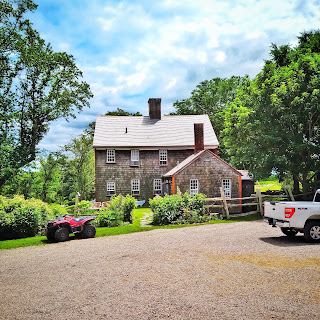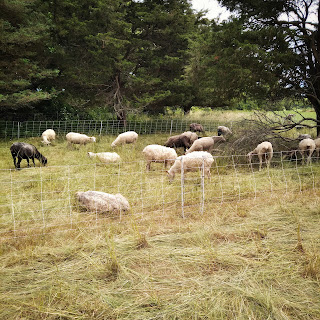Historic New England: Watson Farm

Last Saturday, after a visit to Casey Farm in Saunderstown, Rhode Island, I crossed the bay on Jamestown Verrazzano Bridge and visited Watson Farm in Jamestown, RI. While both properties are owned by Historic New England (HNE) with 18th century farmhouses and heritage breed animals, not to mention that they are located a quick seven minute drive apart in southern Rhode Island, the farms could not be more different.

Overview
Watson Farm is a working family farm on 265 acres with a farmhouse, barn, walking trails, pastures, and a beach. The farm manager and family live in the late Georgian style farmhouse, which is not open to the public. The signage, self-guided walking tour booklet, and HNE employee emphasize that visitors should not go too near the house or look in the windows.


Farm History
Watson Farm is located on Conanicut Island, which was inhabited by the Narragansett before 1657. The Narragansett regularly burned the land to clear the island for growing crops. Meanwhile, the European settlers in Newport let their cattle graze on the island grass. However, the Newporters needed more land for their hungry cattle, so a coalition of ninety-eight Newport farmers bought the island from the Narragansett for 100 pounds’ worth of wampum. I do not know enough about the exchange rate between wampum and 17th century English currency to know if this was a fair trade. I did find an interesting article, "From Beads to Bounty", which describes the history of wampum.


For the next 140 years, landlords held control of the land and brought in tenant farmers to grow crops and raise livestock. At what would become Watson Farm, the line of landlords was from the Loyalist Brenton-Sandford-Hutchinson family, passing the land to a son-in-law or daughter. A poll from 1767 revealed that horses, cattle, sheep, and pigs were kept on the farm, along with literal tons of hay, grass, and grain to feed them. These grounds were tended by five enslaved people along with the tenant farmer.


The State of Rhode Island seized the property during the Revolutionary War in 1780. The land was given as payment to officers in the Rhode Island State Regiment, then promptly sold by the officers. By 1796, the farm was purchased by Job Watson for his son Robert, and the land finally acquired its name and farmhouse. The property remained in the Watson family until 1979, when Thomas Carr Watson Jr. bequeathed it to Historic New England.





Heritage Animals
Watson Farm raises sheep and cattle, with their specialty being Red Devon cattle. During the summer, when the farm is open, the animals graze in pastures accessible by walking trail. These are the same breeds raised on the farm in the 17th and 18th centuries. Red Devon cattle arrived in Plimoth Colony in 1623, only three years after the landing of the Mayflower. Sheep wool was a valuable export, and today’s Rhode Island Sheep Cooperative continues to make blankets and provide meat to locals.




A modern windmill pubs stands in the middle of a pasture and pumps water out of an eighty-foot well into a 2,000 gallon wood storage tank, which takes six hours to fill on a windy day. The windmill is crucial for the farm because of the amount of water drank by cattle, up to ten gallons a day per cow!



Down by the Bay
The pathway leads down to a beach that was once the site of a ferry landing, the easiest way to get to Conanicat Island before the construction of the first Jamestown Bridge in 1940. Today, the breezy beach is a good break from the hotter pastures.




Visiting Information
The cost to tour Watson Farm is $10 for adults, $9 for seniors, $5 for students and children, and $25 for the whole family. Admission is free for Historic New England members and Jamestown residents. The farm is open to visitors from 1:00 p.m. to 4:00 p.m. on Thursdays and Saturdays from June 1 through October 11 and on Tuesdays in July and August. No dogs allowed. Tickets for this farm and other properties can be purchased on the My Historic New England website. Be sure to wear sturdy shoes that you don’t mind getting dirty. Note that the long loop is about two miles long and has uneven footing in spots.


Comments
Post a Comment
Feel free to leave a comment on what you liked best about 'Abby Epplett, Historian' and what can be improved. Remember to speak with kindness.